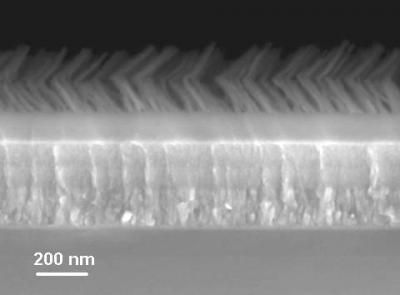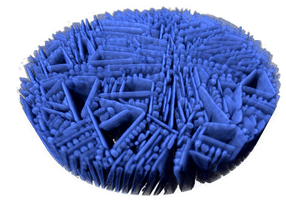Rice study: 'nanostars' could be ultra-sensitive chemical sensors
Scientists observe strong spectral signals from spikes on gold particles
nanophotonics is a rapidly growing field of study that looks at ways to generate and manipulate light using ultrasmall, engineered structures. The virus-sized nanostars, so named because of their spiky surface, are one of a growing number of intricately shaped particles that are increasingly drawing the attention of experts at LANP and other leading photonics labs.
"Just a few years ago, everyone's attention was on the size of nanoparticles because altering size was a straightforward way to change the wavelength of light that the particle reacted with," said lead researcher Jason Hafner, associate director of LANP and assistant professor of physics and astronomy and of chemistry. "Today, researchers are increasingly interested in intricate shapes and the specific ways that those shapes affect a particle's interaction with light."
Most nanophotonic research at LANP involves the study of plasmons, waves of electrons that flow like a fluid across metal surfaces. Light can be used to amplify plasmon waves on metal nanoparticles. Like a child in a bathtub, rhythmically building waves until they slosh out of the tub, the plasmons on the particles dramatically amplified with wavelengths of light that correspond to the rhythm of the electron waves. The study of plasmonics is one of the fastest growing fields in optics because it could prove useful for a wide range of applications in biological sensing, microelectronics, chemical detection, medical technology and others.
Nanostars incorporate some of the best properties of oft-studied photonic particles like nanorods and quantum dots. For example, they deliver strong spectral peaks that are easy to distinguish with relatively low-cost detectors. But Hafner's team found unique properties too. A painstaking analysis revealed that each spike on a nanostar has a unique spectral signature, and preliminary tests show that these signatures can be used to discern the three-dimensional orientation of the nanostar, which could open up new possibilities for 3-D molecular sensing.
"We are just getting started with our follow-up work, but nanostars clearly offer some exciting possibilities," said Hafner, assistant professor of physics and astronomy and of chemistry. "Their extreme sensitivity to the local dielectric environment is a particularly attractive quality for molecular sensing."
Most read news
Topics
Organizations
Other news from the department science

Get the chemical industry in your inbox
From now on, don't miss a thing: Our newsletter for the chemical industry, analytics, lab technology and process engineering brings you up to date every Tuesday and Thursday. The latest industry news, product highlights and innovations - compact and easy to understand in your inbox. Researched by us so you don't have to.
Most read news
More news from our other portals
See the theme worlds for related content
Topic world Sensor technology
Sensor technology has revolutionized the chemical industry by providing accurate, timely and reliable data across a wide range of processes. From monitoring critical parameters in production lines to early detection of potential malfunctions or hazards, sensors are the silent sentinels that ensure quality, efficiency and safety.

Topic world Sensor technology
Sensor technology has revolutionized the chemical industry by providing accurate, timely and reliable data across a wide range of processes. From monitoring critical parameters in production lines to early detection of potential malfunctions or hazards, sensors are the silent sentinels that ensure quality, efficiency and safety.



























































